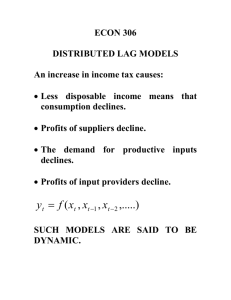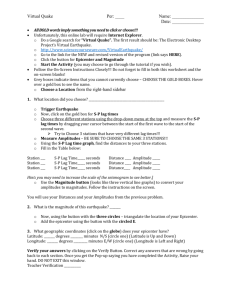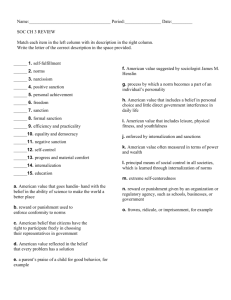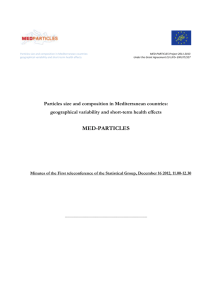A Power-Law Model of Psychological Memory Strength in Short-Term
advertisement
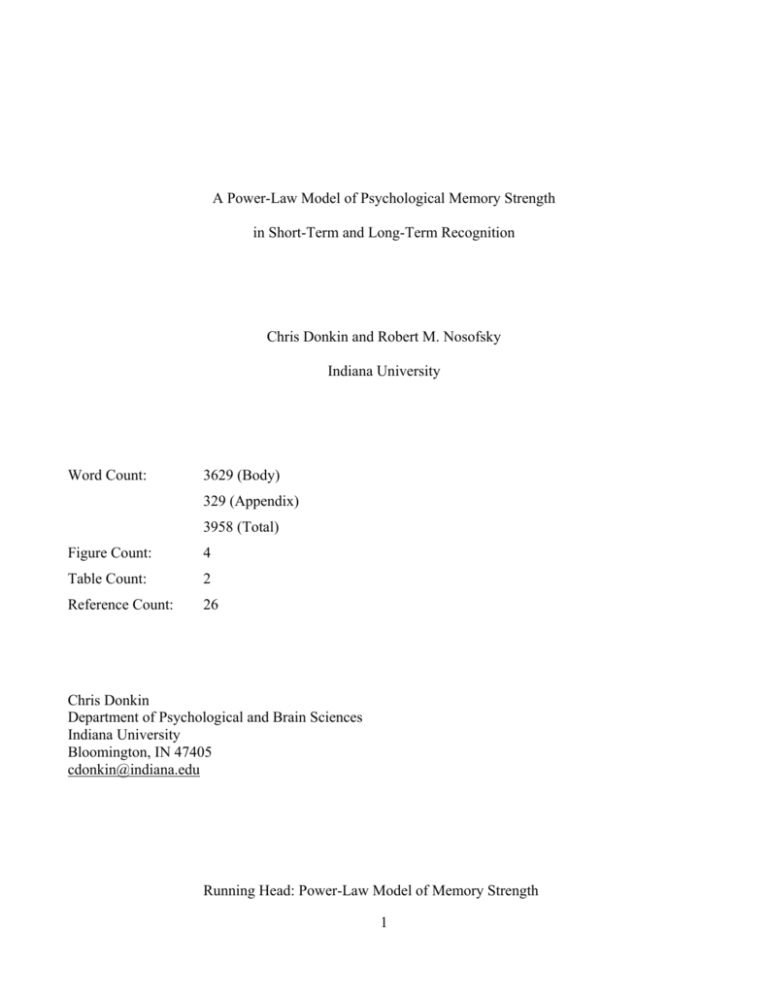
A Power-Law Model of Psychological Memory Strength in Short-Term and Long-Term Recognition Chris Donkin and Robert M. Nosofsky Indiana University Word Count: 3629 (Body) 329 (Appendix) 3958 (Total) Figure Count: 4 Table Count: 2 Reference Count: 26 Chris Donkin Department of Psychological and Brain Sciences Indiana University Bloomington, IN 47405 cdonkin@indiana.edu Running Head: Power-Law Model of Memory Strength 1 Abstract A classic law proposed in cognition is that forgetting curves are closely approximated by power functions. Such results describe relations between different empirical dependent variables and the retention intervaltime, and the precise form of the functional relation must depend on the scale used to measure each variable. In this research, we conduct a speeded probe-recognition task involving both short-term and long-term probes. We discover that formal memory-strength parameters from an exemplar-recognition model follow closely a power-function of lag. The model accounts for rich sets of response-time (RT) data at both individual-subject and individual-lag levels. Because the derivation of the memory strengths is based on model fits to choices and RTs from individual trials, the derived power law is independent of the scale that is used to summarize the forgetting functions. Alternative models that assume different functional relations, or posit a separate fixed-strength working-memory store, fare considerably worse than the power-law model in accounting for the data. 2 Among the classic quantitative laws proposed in cognitive psychology is that forgetting functions are well described by power functions (e.g., Anderson & Schooler, 1991; Wickelgren, 1974; Wixted & Ebbesen, 1991). For example, Wixted and Ebbesen (1991) and Wixted and Carpenter (2007) showed that diverse measures of forgetting, including proportion correct in free recall of word lists, recognition judgments of faces, and savings in re-learning lists of nonsense syllables, were well described as power functions of the retention interval. However, as discussed in depth, for example, by Wixted and Ebbesen (1991, p. 414), these results involved relations between the retention interval and a variety of empirical dependent variables. Each such dependent variable is associated with some particular scale of measurement, and the precise quantitative law that describes relations between the variables must depend on the scale of measurement that is chosen. For example, the precise form of the function that relates forgetting to the retention interval will vary depending on whether performance is measured in terms of percent correct versus d’. In the present work, we test participants in a speeded old-new recognition paradigm involving both short-term and long-term probes. The key independent variable involves the lag with which a test probe was presented on the study list. Lag is defined as the number of items back in the memory set from the probe. For example, the most recently presented study-list item has lag 1, the next most recent item has lag 2, and so forth. We apply a modern exemplar-based recognition model (Nosofsky, Little, Donkin, & Fific, 2011) to account for individual-subject choice probabilities and response times observed in the task. Application of the formal model allows one to estimate a set of parameters that describe the strength with which each exemplar from the study list is stored in memory. In applying the model, we make a remarkable discovery: Except for a small residual primacy effect, the estimated memory strengths are almost a perfect power function of the lag with which the original exemplars were presented on the study lists. Whereas the previous evidence for a power law relied on measured relations between a variety of empirical dependent variables and the retention interval, the present regularity involves a latent 3 psychological variable (“memory strength” parameters). Thus, the obtained evidence for a power law of memory is found at a deeper, theoretical level of analysis. Furthermore, as will be seen, because the estimated memory strengths are based on model fits to choices and RTs from individual trials, the derived power law is independent of the scale that is used to summarize the empirical forgetting functions. Before proceeding to the report of the experimental paradigm and the modeling results, we highlight two other key contributions of the work. First, although previous research has demonstrated remarkable generality and precision for a power-law of forgetting, the function has been used to describe limited amounts of data. In the examples reported by Wixted and Ebbesen (1991), for example, the individual forgetting functions were composed of four or five data points. By comparison, when we combine the exemplar-based recognition model with the power law of memory strength, we will be accounting for enormously rich sets of RT-distribution data at both the individual-subject and individual-lag levels. Extremely accurate accounts of mean correct RTs and error RTs as well as hit and false-alarm rates and d’ as a function of lag will emerge naturally from the formal model as well. Second, our research will also broach the question of whether the assumption of distinct workingmemory and long-term-memory stores is needed to account for the present forms of data. A longstanding debate is whether working memory involves a time- or capacity-limited system that is distinct from the system that underlies long-term memory (e.g., Atkinson & Shiffrin, 1968; Baddeley & Hitch, 1974; Cowan, 2001; Oberauer, 2002). An alternative view is that the same principles and processes govern both short- and long-term memory (e.g., Brown, Neath, & Chater, 2007; Crowder, 1993; McElree, 2006; Nairne, 2002). The present recognition paradigm involves both short-term and longterm probes. To the extent that the details of all of the recognition data are captured by a model that presumes that psychological memory strength is a simple and continuous function of lag, it brings into question the hypothesis that distinct working-memory and long-term-memory systems are operating. Nevertheless, we compare one such separate-systems model to the power-law model proposed here. 4 Experiment Following a recent paradigm reported by Öztekin, Davachi, and McElree (2010), observers were presented with 12-item memory sets followed by a test probe. They were required to make speeded recognition judgments of whether the probe was “old” or “new”. In an effort to establish a direct correspondence between psychological and experimenter-defined lag, in the present experiment we provided explicit instructions so as to place rehearsal strategies under control. Individual subjects were tested for extended periods, allowing us to collect detailed RT-distribution and choice-probability data at the level of individual subjects and individual lags. Participants Four participants, two in a letters condition and two in a words condition, completed 10 one-hour sessions on separate days. Participant 4 was the first author. Other participants were reimbursed $12 per session (including a bonus for accuracy above 75%). Stimuli In the letters condition, items were the 26 English letters, excluding A and E. In the words condition, a list of 1535 one-syllable, three-to-six letter words was generated using the MRC Psycholinguistic Database (http://www.psy.uwa.edu.au/mrcdatabase/uwa_mrc.htm). Items were presented in the center of a computer monitor at a visual angle of approximately 3-4 degrees. Procedure Each trial began with a fixation cross for 500ms. 12 items were then presented, each for 500ms and a 100ms break between successive items. After the study list, an asterisk appeared for 500ms to signal the 5 probe. The probe remained onscreen until a response was made. Participants indicated whether the probe was “old” (“F” key) or “new” (“J”). Feedback was provided for 1000ms, followed by a 1500ms intertrial interval. Participants were given clear and repeated instructions regarding rehearsal. They were asked to say each item (silently, to themselves) once as it was presented, and to avoid rehearsing previously presented stimuli or developing any special strategies for remembering items. At the start of each trial, a study list was created by randomly sampling 12 items from the stimulus set. The probe was a member of the study list (a target) on half the trials, and was a randomly sampled item not on the study list (a lure) on the other half of trials. On target trials, each serial position was probed equally often, with the order of all trials randomized within a block. Each session comprised 5 blocks of 48 trials. For each participant, 10 sessions yielded 1200 trials on which the probe was a lure and 100 trials of each serial position when the probe was a target. Results Responses faster than 200ms or slower than 5000ms were excluded. For each participant, and separately for correct and incorrect responses in each of the 13 conditions (12 serial positions and 1 lure condition), we removed responses slower than 3 standard deviations above the mean RT in that condition. We removed 1.08% of responses in total. Accuracy (measured in d’) and mean RT for correct responses are plotted as a function of lag for each participant in Figure 1 (open circles). Although participants were more accurate in recognizing words than letters, the influence of study-probe lag is the same in both conditions: At early lags, performance declines quickly (i.e., RT slows and d’ decreases); at later lags, performance continues to decline, but at a slower rate. There is also a small primacy effect, in which performance for items at the greatest lags (first and second serial positions of the study list) sees a slight boost. Öztekin et al. (2010, 6 Figure 2) observed a similar pattern of results, although their data were averaged across participants and pairs of adjacent serial positions. Figure 2 shows detailed RT distributions for each of the study-probe lag conditions for representative Participant 3. (The RT distributions for the other participants were essentially identical in form to those shown in the figure and are shown in an on-line supplement.) We illustrate the RT distributions using cumulative distribution function plots. These plots provide an efficient means of simultaneously illustrating accuracy and the form of the correct (“hit”) and incorrect (“miss”) RT distributions in each lag condition. Each plot is made up of quantile estimates from correct and incorrect RT distributions. The quantile estimates (diamond symbols) show the RT below which 10%, 30%, 50%, 70% and 90% of the responses in that distribution fall. The positions of the quantiles on the x-axis reflect the speed at which responses are made, so that slower distributions stretch further to the right. The heights of the quantiles indicate, separately for correct and incorrect trials, the absolute cumulative proportion of responses with RTs below the quantile cutoff. Therefore, note that the relative heights of the correct and incorrect distributions reflect the proportion of correct vs. incorrect responses at each cumulative RT. The curves asymptote at the overall correct and incorrect response proportions at each lag. Inspection of Figure 2 indicates a systematic effect of lag on the RT distributions. As lag increases, the median of each distribution (third diamond within each plot) shifts to the right and the distribution becomes more positively skewed (the points spread out to the right). This tendency is pronounced at the early lags, and slows down for the larger ones. Figure 3 shows the RT distributions (for all individual participants) for trials on which the probe was a lure. The general form of the lure RT distributions is the same as for the targets. We now demonstrate that all of these results are captured in precise quantitative fashion by a simple version of an exemplar-recognition model that assumes that memory strength is a power function of lag. 7 Model-Based Analysis The Modeling Framework Because presentations of the exemplar-recognition model have been provided in previous articles (Nosofsky & Palmeri, 1997; Nosofsky et al., 2011), here we provide only a capsule summary. According to the model, the items from the study list are stored as individual exemplars in memory. Presentation of a test probe causes the exemplars to be activated and retrieved. The retrieved exemplars drive an evidence-accumulation process that leads the observer to make “old” or “new” decisions. Formally, according to the model, presentation of probe i leads to overall “activation” (Ai) of the items in the memory set, given by (1) ∙ where mj is the memory strength associated with the item at lag j, and sij is the similarity of the probe to the item at lag j. For the present paradigm, an exceedingly simple model of similarity is applied: If the probe matches the item at lag j, then sij is set equal to one; whereas if the probe mismatches, then sij is set equal to a free parameter s (0 < s < 1). In the general version of the model, the individual memorystrengths mj are freely estimated parameters; past evidence from paradigms with small memory-set sizes indicates that the magnitude of the memory strengths decreases with increasing lag (Nosofsky et al., 2011; see also Kahana & Sekuler, 2002). Based on results from applying the general model (see below), we also apply a special case in which it is assumed that memory strength is a decreasing power function of lag j: (2) ∙ 8 where β measures the rate at which memory strength declines with lag. (The parameter α is a scaling parameter; without loss of generality, its value can be set at α=1 in the present model.) Because of small primacy effects in the data, the memory strengths for items in serial positions 1 and 2 were scaled by free parameters γ1 and γ2. According to the exemplar model, the mean rate of evidence accumulation towards an “old” response is given by (3) where k is a “drift-rate criterion” parameter. The mean rate of evidence accumulation towards a “new” response is simply 1 . So, for example, if a probe leads to high activation of the memory set items (e.g., because it matches a recently presented member of the memory set), then there will be a high rate of evidence accumulation towards making an old response. If the accumulating evidence first reaches an “old” response threshold (Rold), then the observer responds “old”; whereas if the evidence first reaches a “new” response threshold (Rnew) then the observer responds “new”. The decision time is determined by the time that it takes the accumulating evidence to reach either threshold. In past applications of the model, the evidence-accumulation process was modeled as a “random walk”, in which a single counter moved probabilistically on each step towards either the “old” or “new” threshold. As explained in the appendix, in the present article we apply a slight variant in which the evidence-accumulation process is modeled in terms of linear-ballistic accumulation instead (Brown & Heathcote, 2008). Finally, as is commonly assumed in numerous RT models, the exemplar model includes parameters for between-trial variability in the start-point of the evidence accumulation process (a); between-trial variability in the evidence-accumulation rate (σ); and a mean residual time (μ) for processes not 9 associated with decision making (e.g., encoding and response-execution). Details are provided in the appendix. Fitting Procedure Models were fit to individual-trial, correct and incorrect RTs using analytic expressions of likelihood (see Brown & Heathcote, 2008, for details). The general and power-law versions of the exemplar model share seven parameters (see previous discussion, the appendix, and Table 1): s, k, Rold, Rnew, a, σ, and μ. The general (i.e., free memory-strength) model estimated 12 further mj parameters, one memory strength for each lag. The special-case power-law model instead estimated the decay-rate β and primacy parameters γ1 and γ2. Model comparisons were made using the well-known Bayesian Information Criterion (BIC), which combines measures of absolute fit and a penalty for number of free parameters to determine which model provides the most parsimonious explanation of the data. Smaller values of BIC indicate the preferred model. Details are provided in the appendix. Model Fits Table 1 reports the BIC values and best-fitting parameter estimates for the general and power-law versions of the exemplar model for each individual participant. In all cases, the BIC yielded by the power-law model is superior to the one yielded by the more general version. This result indicates that the additional parameters utilized by the more general model did not provide enough of a benefit in quality of fit to offset its increased complexity. To provide further evidence for the utility of the power-law model, we fitted a variety of competing functions (the same ones considered previously by Wixted and Ebbesen, 1991) to the lag 1-10 memory strengths estimated from the general version of the exemplar model. In the analysis, we found the two free parameters of each function that minimized the sum of squared deviations between the function’s 10 predictions and the estimated memory strengths. The results of this analysis are shown in Table 2. Impressively, for all four participants, the power function provides, by far, the best description of the estimated memory strengths. Indeed, as shown in Figure 4, when one plots the estimated memorystrength parameters from the general model against lag, it can be seen that the plots follow closely a power function for all participants. Most important, the version of the exemplar model that assumes a lag-based power law provides an outstanding account of all of the detailed RT-distribution data. To demonstrate this point, we plot its predictions of the full RT distributions for correct and incorrect responses in both target-present and target-absent conditions in Figures 2 and 3. (Recall that Figure 2 shows the target-present results for only Participant 3; the results for the other three participants are equally impressive.) The quality of the agreement between the model and the data is excellent, especially given that only 10 parameters were used to simultaneously fit each participant’s 26 RT distributions (2400 data points per participant). Because the model captures the detailed form of the correct and incorrect RT distributions at each lag, it naturally also accounts extremely well for the overall accuracy and mean RT data -- see Figure 1. Dual-Store Model As another source of comparison, we fitted a representative from the class of dual-store models to the RT-distribution data. In the dual-store model, we assumed that, as each individual item was presented, it entered into a working-memory buffer of size 4 (e.g., Cowan, 2001; Oberauer, 2002). Once the buffer size was exceeded, one of the items already existing in the buffer was displaced into a separate long-term store. The displaced item was assumed to be chosen at random. Based on the all-ornone properties deemed to characterize working memory in recent work (e.g., Rouder et al., 2008; Zhang & Luck, 2009), we assumed that all items present in the working-memory buffer had equal memory strength mWM. By contrast, items displaced into long-term memory had (lower) average strength mLTM. We also granted the dual-store model the same flexibility as the power-law model by 11 estimating separate primacy-strength parameters for the items in serial positions 1 and 2. The manner of computing overall activation and evidence accumulation for this dual-store model was the same as we have already described for the other versions of the exemplar model. Note that the dual-store model is a mixture model. On some proportion of trials, the overall activation yielded by a positive probe will be high, because it resides in the working-memory buffer. On the remaining proportion of trials, the overall activation will be low, because the item has been displaced into long-term memory. Items with shorter lags will yield a higher proportion of trials with high activations, because there is a higher probability that they still exist in the working-memory buffer. The fits of the dual-store model are shown along with those of the other versions of the exemplar model in Table 1. In all cases, it provides a substantially worse account of the data than does the powerlaw model. Except for Participant 1, it also fares much worse than does the free-memory-strength version. In our view, the version of the dual-store model that we tested is a reasonable representative, but we acknowledge that a wide variety of alternative dual-store models could be formulated. The precision of fit achieved by the power-law model provides a challenging yardstick to gauge such alternative formulations. Discussion We found strong evidence for an exemplar-recognition model that assumed a power-function relationship between psychological memory strength and lag. The model, despite its parametric simplicity, was able to produce a remarkably good fit to data from a probe-recognition task in which lists of 12 items (made of either letters or words) were presented. The model accounted simultaneously for full RT distributions for correct and incorrect responses across all serial positions of target-present trials and also for target-absent trials. A wide variety of alternative functions failed to capture the relation between estimated memory strength and lag. An alternative dual-store model that posited an all- 12 or-none, limited-capacity working-memory buffer also fared considerably worse than the power-law model. Because our analysis was aimed at fine-grained RT distributions observed for individual subjects at individual lags, the support for the power law is almost certainly not due to artifacts involving averaging across subjects artifacts (e.g., Anderson & Tweney, 1997; Myung, Kim, & Pitt, 2000; Wixted & Ebbesen, 1997). Furthermore, because the memory-strength parameters were required to account for enormously rich sets of data, there is a great deal of precision in their estimates. Therefore, the support for the power law is unlikely to be due to flexibility in fitting noisy estimates (Lee, 2004). Analogous to other work involving the discovery of laws at a psychological level of analysis (e.g., Shepard, 1987), the present regularity was uncovered within the framework of a highly successful formal model. It is important to acknowledge, therefore, that the discovered regularity involving the memory strengths is model-dependent. However, because the model combines well-established principles of exemplar-based recognition and evidence accumulation for which there is a good deal of consensus, we believe that the discovered regularity is intriguing and important. Natural questions arise regarding the generality of our findings and the conditions under which the power function holds. From one perspective, past research already suggests considerable generality for a power-law of forgetting, because it has been found to hold widely for empirical forgetting functions. Wixted (2004) considered a variety of possible reasons for the emergence of the empirical power law. He suggested (p. 875) that the best explanation was that “…the underlying memory traces themselves individually exhibit an ever-decreasing rate of decay…,” which is a property consistent with power-law forgetting. Our model-based evidence for such power-law decreases in psychological memory strength lends support to Wixted’s suggestion. Nevertheless, future research needs to test more directly for the generality with which the psychological power law holds. An interesting possibility is that the powerfunction relation might hold quite generally, but the parameters of the function might be systematically 13 influenced by experimental factors such as the similarity of the items within the study lists, the time interval between each item presentation, and so forth. Finally, the present theoretical message has been to provide evidence for a power law of memory strength at a psychological level of analysis. The work does not provide any explanation as to why the power law is favored over various alternatives. In addition, in its present preliminary form, the power law is stated with respect to “lag”. Future research needs to unpack the detailed psychological and neurological mechanisms, such as decay, interference, and consolidation, which contribute to the form of the lag-based forgetting functions, leading to the development of more fully specified models and laws of psychological memory strength. 14 Appendix – Model Details and Fitting Procedure In past applications of the exemplar model (e.g., Nosofsky et al., 2011), the evidence-accumulation rates defined in Equation 3 were used to drive a discrete random-walk process. Here, we apply instead a continuous linear-ballistic-accumulation (LBA) process (Brown & Heathcote, 2008). Past work suggests that the LBA approach yields predictions that are essentially the same as random-walk and diffusion models (Donkin et al., 2011). An advantage of the LBA approach relative to the random-walk model, however, is that analytic expressions have been developed to allow maximum-likelihood fits to RTdistribution data without requiring simulation; and the continuous nature of the LBA model provides for more graceful parameter-search methods. For the current exemplar-based LBA model, two accumulators are established, one for “old” responses and one for “new”. On each individual trial, the evidence-accumulation rate on each accumulator is an independent and randomly sampled value from normal distributions with means given by the values pi and qi computed from Equation 3; and common standard deviation σ. The start point of each accumulator is an independent and randomly sampled value from uniform distribution [0, a]. As assumed in all LBA applications, evidence accumulates at a linear and ballistic rate (i.e., without moment-to-moment noise), until a response threshold is reached in either accumulator. The response whose threshold was reached is made, and the time taken for evidence to reach that threshold is the decision time for that trial. The predicted RT is the sum of the decision time and non-decision time, μ. The fits of the models were evaluated in terms of BIC = -2·lnL + P·lnN, (A1) where L is the (maximum) likelihood of the data given the model parameters, P is the number of free parameters, and N is the total number of data points. Smaller values of BIC indicate the preferred model. An identical pattern of model-fitting results and conclusions was obtained when we used the alternative Akaike Information Criterion (AIC) as a criterion of fit. 15 References Anderson, J.R., & Schooler, L.J. (1991). Reflections of the environment in memory. Psychological Science, 2, 396-408. Anderson, J.R., & Tweney, R.D. (1997). Artifactual power curves in forgetting. Memory & Cognition, 25, 724-730. Atkinson, R.C., & Shiffrin, R.M. (1968). Human memory: A proposed system and its control processes. In K.W. Spence & J.T. Spence (Eds.), Advances in the psychology of learning and motivation: Vol. 2. Research and theory (pp. 89-195). New York, NY: Academic Press. Baddeley, A.D., & Hitch, G.J.L. (1974). Working Memory. In G.A. Bower (Ed.), The Psychology of Learning and Motivation: Advances in Research and Theory: Vol 8 (pp. 47-89). New York, NY: Academic Press. Brown, G.D.A., Neath, I., & Chater, N. (2007). A temporal ratio model of memory. Psychological Review, 114, 539-576. Brown, S.D., & Heathcote, A. (2008). The simplest complete model of choice reaction time: Linear ballistic accumulation. Cognitive Psychology, 57, 153-178. Cowan, N. (2001). The magical number 4 in short-term memory: A reconsideration of mental storage capacity. Behavioral and Brain Sciences, 24, 87-185. Crowder, R.G. (1993). Short-term memory: Where do we stand? Memory & Cognition, 21, 142-145. Donkin, C., Brown, S.D., Heathcote, A., & Wagenmakers, E.-J. (2011). Diffusion versus linear ballistic accumulation: Different models but the same conclusions about psychological processes? Psychonomic Bulletin & Review, 18, 61-69. Kahana, M.J., & Sekuler, R. (2002). Recognizing spatial patterns: A noisy exemplar approach. Vision Research, 42 2177-2192. 16 Lee, M.D. (2004). A Bayesian analysis of retention functions. Journal of Mathematical Psychology, 48, 310-321. McElree, B. (2006). Accessing recent events. In B.H. Ross (Ed.), The Psychology of Learning and Motivation, Vol. 46 (pp. 155-200). San Diego: Academic Press. Myung, J., Kim, C., & Pitt, M.A. (2000). Toward an explanation of the power law artifact: Insights from response surface analysis. Memory & Cognition, 28, 832-840. Nairne, J.S. (2002). Remembering over the short-term: The case against the standard model. Annual Review of Psychology, 53, 53-81. Nosofsky, R.M., Little, D.R., Donkin, C., & Fific, M. (2011). Short-term memory scanning viewed as exemplar-based categorization. Psychological Review, 118, 280-315. Nosofsky, R.M. & Palmeri, T.J. (1997). An exemplar-based random walk model of speeded classification. Psychological Review, 104, 266-300. Oberauer, K. (2002). Access to information in working memory: Exploring the focus of attention. Journal of Experimental Psychology: Learning, Memory & Cognition, 28, 411-421. Öztekin, I., Davachi, L., & McElree, B. (2010). Are representations in working memory distinct from representations in long-term memory? Neural evidence in support of a single store. Psychological Science, 21, 1123-1133. Rouder, J.N., Morey, R.D., Cowan, N., Zwilling, C.E., Morey, C.C., & Pratte, M.S. (2008). An assessment of fixed-capacity models of visual working memory. Proceedings of the National Academy of Sciences, 105, 5975-5979. Shepard, R.N. (1987). Toward a universal law of generalization for psychological science. Science, 237, 1317-1323. Wickelgren, W.A. (1974). Single-trace fragility theory of memory dynamics. Memory & Cognition, 2, 775-780. 17 Wixted, J. T. (2004). On common ground: Jost’s (1897) law of forgetting and Ribot’s (1881) law of retrograde amnesia. Psychological Review, 111, 864-879. Wixted, J.T., & Carpenter, S.K. (2007). The Wickelgren power law and the Ebbinghaus savings function. Psychological Science, 18, 133-134. Wixted, J.T., & Ebbesen, E.B. (1991). On the form of forgetting. Psychological Science, 2, 409-415. Wixted, J.T., & Ebbesen, E.B. (1997). Genuine power curves in forgetting: A quantitative analysis of individual subject forgetting functions. Memory & Cognition, 25, 731-739. Zhang, W., & Luck, S.J. (2009). Sudden death and gradual decay in visual working memory. Psychological Science, 20, 423-428. 18 Acknowledgements This work was supported by Grant FA9550-08-1-0486 from the Air Force Office of Scientific Research to Robert Nosofsky. The authors would like to thank Jerry Busemeyer, Rich Shiffrin, and Jim Towsend for helpful discussions, and two anonymous reviewers for their comments on an earlier version of this article. Correspondence concerning this article should be addressed to Chris Donkin, Psychological and Brain Sciences, Indiana University, Bloomington, IN 47505. Email: christopher.donkin@gmail.com. 19 Figure 1 Mean correct RT and accuracy in d’ plotted as a function of study-probe lag. Observed data are shown using open circles. Predictions from the exemplar-recognition power-law model are shown using black lines for targets and Xs for lures. (In computing observed and predicted values of d’, maximum hit rates were set at .99.) 20 Figure 2. Participant 3: Correct (upper) and incorrect (lower) RT distributions for target-present trials are presented using CDF plots. The lag between study and probe is identified by the value following the #. Observed data are shown using connected, open, diamonds. Predictions from the exemplarrecognition power-law model are shown using smaller, connected, Xs. The observed and predicted proportion of correct responses are shown using p and ̂ , respectively. 21 Figure 3. Correct (upper) and incorrect (lower) RT distributions for target-absent (lure) trials are presented for all participants using CDF plots. The format of each plot in Figure 3 is the same as in Figure 2. 22 Figure 4. Memory strength in the general model (open circles) and the predicted memory strength from the best-fitting power function (black line) plotted as a function of lag. 23 Table 1. Parameter estimates and BIC values for each participant for each of the general (G), power-law (PL) and dual-system (DS) versions of the exemplar model. The smallest BIC value has been bolded for clarity. a Rold Rnew µ s k σ γ1 γ2 β mLTS m1 m2 m3 m4 m5 m6 m7 m8 m9 m10 m11 m12 BIC 1 G PL 0.50 0.49 0.77 0.77 0.78 0.78 0.20 0.20 0.06 0.03 0.05 0.08 0.19 0.19 2.51 1.55 1.60 1.000 0.413 0.190 0.143 0.087 0.084 0.044 0.040 0.035 0.033 0.040 0.057 3677 3611 DS 0.55 0.79 0.78 0.24 0.003 0.02 0.17 0.97 0.57 0.01 3683 2 G PL 0.11 0.11 0.25 0.25 0.29 0.29 0.17 0.17 0.04 0.04 0.09 0.14 0.17 0.17 1.00 1.00 1.52 1.000 0.210 0.142 0.088 0.050 0.043 0.043 0.029 0.026 0.024 0.022 0.013 -4039 -4087 DS 0.13 0.25 0.28 0.19 0.02 0.15 0.17 0.26 0.42 0.06 -3766 G 0.07 0.25 0.27 0.16 0.03 0.13 0.11 1.000 0.230 0.200 0.113 0.103 0.077 0.074 0.056 0.050 0.052 0.053 0.045 -2902 3 PL 0.07 0.25 0.28 0.14 0.05 0.22 0.10 1.22 1.30 1.11 -2954 DS 0.07 0.25 0.28 0.15 0.04 0.35 0.11 0.56 0.69 0.20 -2639 G 0.00 0.30 0.28 0.10 0.08 0.06 0.11 1.000 0.334 0.166 0.111 0.069 0.071 0.046 0.043 0.043 0.044 0.046 0.053 -1810 4 PL 0.02 0.32 0.30 0.08 0.05 0.15 0.11 2.12 1.64 1.38 -1871 Note. Without loss of generality, m1 = 1 in the general version of the model, mWM = 1 in the dual-store version of the model, and α = 1 in the power-law version of the model. The parameters a, Rold, Rnew, and µ are measured in units of seconds. The parameters of the models are defined as follows (see text and the appendix for further details): a = start-point variability, Rold = “old” response threshold, Rnew = “new” response threshold, µ = mean residual time, s = similarity, k = drift-rate criterion, σ = drift-rate variability, γi = primacy scaling factor for serial-position i, β = power-function decay rate, mLTS = memory strength for items in long-term store, mj = memory strength for lag j. 24 DS 0.04 0.32 0.29 0.10 0.03 0.18 0.11 0.79 0.71 0.09 -1721 Table 2 Sum of squared deviations (SSD) for each of the six candidate forgetting functions (Wixted & Ebbesen, 1991) fit to each of the four participants’ estimated memory-strength parameters. Smaller values of SSD indicate a better fitting function. The smallest SSD for each participant is bolded. Function Power Exponential Hyperbolic Linear Logarithmic Exp-power Equation -β m = α·t m = α·e-βt m = α / (1+β·t) m = α – β·t m = α – b·log(t) m = α·e-2·β·√t Participant (SSD) 2 3 0.0044 0.0138 0.0205 0.0508 0.1443 0.0955 0.4542 0.4096 0.2348 0.2087 0.0165 0.0329 1 0.0027 0.0148 0.0649 0.3537 0.1349 0.0037 Note. t = lag, m = memory strength. 25 4 0.0008 0.0190 0.0087 0.4007 0.1790 0.0079 Online Supplement Figure OS1 Response time distributions as a function of lag for Participant 1. The figure has the same format as Figure 2 in the manuscript. 26 Figure OS2 Response time distributions as a function of lag for Participant 2. The figure has the same format as Figure 2 in the manuscript. 27 Figure OS3 Response time distributions as a function of lag for Participant 4. The figure has the same format as Figure 2 in the manuscript. 28

